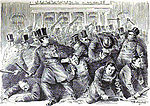Actors Studio Drama School at Pace University
2006 establishments in New York CityAC with 0 elementsActors StudioDrama schools in the United StatesEducational institutions established in 2006 ... and 5 more
Pace UniversityPerforming arts education in New York CityUniversities and colleges in ManhattanUniversities and colleges in New York CityUniversity subdivisions in New York (state)
The Actors Studio Drama School at Pace University is a three-year graduate program in the theater arts. It has been located at Pace University in New York since 2006 and grants Master of Fine Arts degrees in acting, directing, and playwriting. James Lipton served as Dean Emeritus. The program is sanctioned by the Actors Studio, though graduation from the school does not guarantee membership in the Actors Studio.
Excerpt from the Wikipedia article Actors Studio Drama School at Pace University (License: CC BY-SA 3.0, Authors).Actors Studio Drama School at Pace University
Brooklyn Bridge Promenade, New York Manhattan
Geographical coordinates (GPS) Address Website Nearby Places Show on map
Geographical coordinates (GPS)
| Latitude | Longitude |
|---|---|
| N 40.71136 ° | E -74.00513 ° |
Address
Pace University
Brooklyn Bridge Promenade
10000 New York, Manhattan
New York, United States
Open on Google Maps








